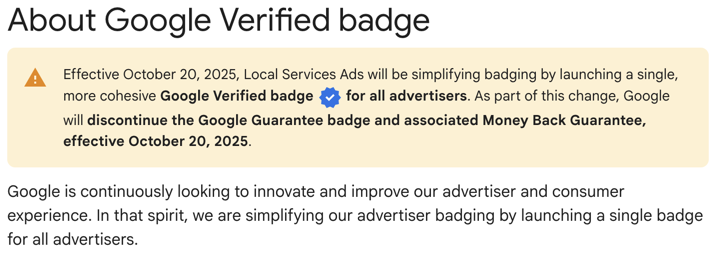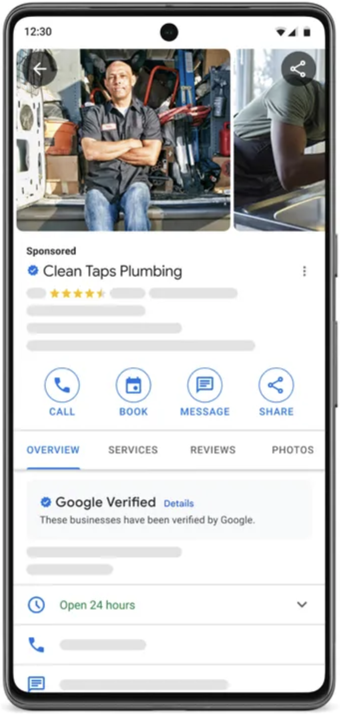Greetings, everybody. We hope it’s been a great week for all of you.
We’ve written several recent blog posts about well-marketed businesses no longer showing up in local search as far and wide as they once did. An effective solution that we suggested was running Local Services Ads for yourselves and your clients. They work.
 Google plans to change the LSA badge system in a little under a month. The $2,000 consumer reimbursements that were tied to the Google Guaranteed badge have been innovated into a Google Verified badge that carries no such promises. The Google Screened and License Verified by Google badges are transforming into the Google Verified badge as well.
Google plans to change the LSA badge system in a little under a month. The $2,000 consumer reimbursements that were tied to the Google Guaranteed badge have been innovated into a Google Verified badge that carries no such promises. The Google Screened and License Verified by Google badges are transforming into the Google Verified badge as well.
 Businesses already sporting one of the three soon-to-be-extinct badges do not need to do anything to get the new Google Verified badge to appear next to their Local Services Ads. Businesses wanting to become Google Verified need to meet the requirements (show they’re licensed, insured, and have workers without a history of violence) and undergo a screening and verification process (mostly submitting paperwork).
Businesses already sporting one of the three soon-to-be-extinct badges do not need to do anything to get the new Google Verified badge to appear next to their Local Services Ads. Businesses wanting to become Google Verified need to meet the requirements (show they’re licensed, insured, and have workers without a history of violence) and undergo a screening and verification process (mostly submitting paperwork).
In addition to LSA, the Google Verified badge “may dynamically appear on other surfaces where it adds consumer value.” No “surfaces” are specified, so only time will tell where the badge will show up.
There’s a Google Verified post on the Ads & Commerce Blog if any of you would like to dig deeper. You won’t be digging much deeper though, as that link takes you to a two paragraph stub. We had to gather Local Services Help documentation to find the information we did.
 Today’s first closing link is about micro-drama apps like ReelShort (which works on iOS and Android) and DramaBox (also on iOS and Android). They’re now a $1.3 billion business in the United States (and command a bigger market in China). These apps serve up vertical, phone-formatted soap operas that are sliced into numerous short clips. So yeah– now you know this exists. Next, from Later, is YouTube Marketing: Ultimate Guide for Brands in 2025. Finally, from Search Engine Journal, is And The Truth? This Writing Style Screams AI. It’s about spotting generative AI-written text. “AI writing has a rhythm problem. The sentences are clipped. Overly dramatic. Split into one-line paragraphs that feel more like infomercials than journalism.” We do not wholeheartedly agree with this assessment (part of the byline is that AI writing “makes everything feel like the world is ending,” which is an interesting perspective), but it’s a fun read.
Today’s first closing link is about micro-drama apps like ReelShort (which works on iOS and Android) and DramaBox (also on iOS and Android). They’re now a $1.3 billion business in the United States (and command a bigger market in China). These apps serve up vertical, phone-formatted soap operas that are sliced into numerous short clips. So yeah– now you know this exists. Next, from Later, is YouTube Marketing: Ultimate Guide for Brands in 2025. Finally, from Search Engine Journal, is And The Truth? This Writing Style Screams AI. It’s about spotting generative AI-written text. “AI writing has a rhythm problem. The sentences are clipped. Overly dramatic. Split into one-line paragraphs that feel more like infomercials than journalism.” We do not wholeheartedly agree with this assessment (part of the byline is that AI writing “makes everything feel like the world is ending,” which is an interesting perspective), but it’s a fun read.
That’s all for today. Enjoy the last weekend of September.